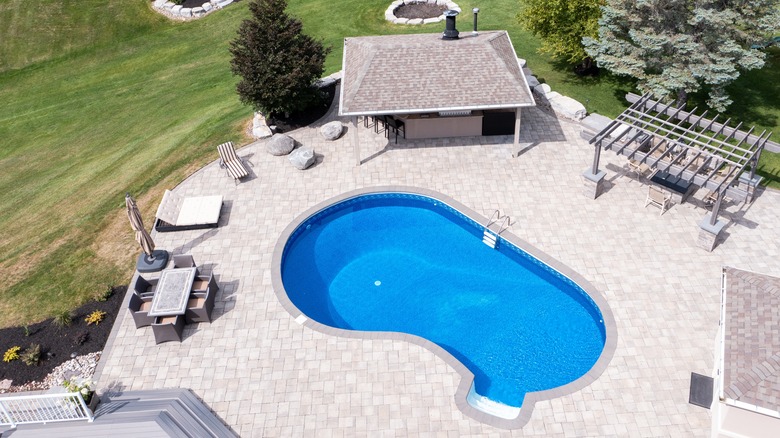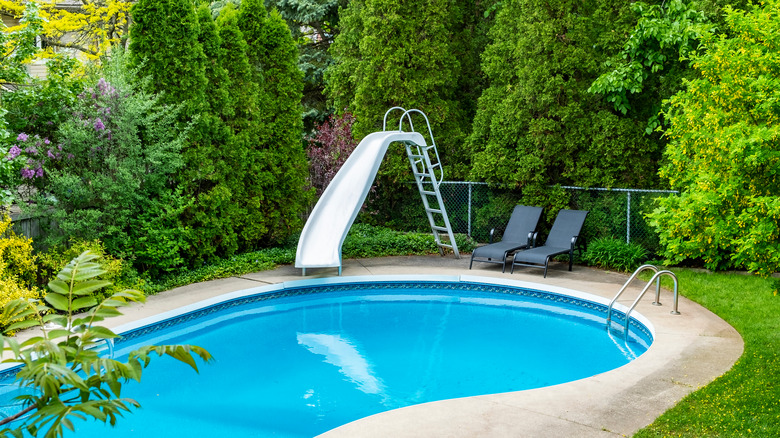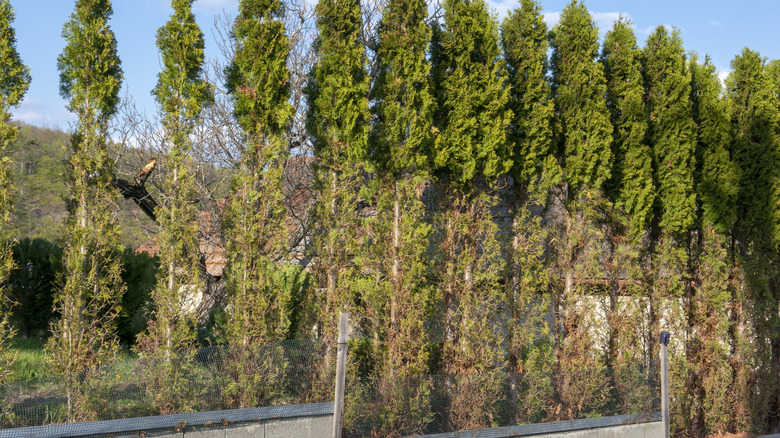The Low-Maintenance Tree To Grow Around Your Pool For Extra Privacy
With a private pool in the backyard, you can turn a summer spent at home into a rejuvenating and relaxing staycation. But one thing can ruin that vacation experience at your own house: Looky-loos and envious neighbors. If you're looking for a natural landscaping idea that will create privacy in your backyard, planting the Emerald Green Arborvitae (Thuja occidentalis Smaragd) is your best bet.
This plant has been a longtime favorite of homeowners and landscapers for its beauty, hardiness, and easy maintenance. The fast-growing, elegant evergreen tree can grow up to 14 feet high, maintains a slim 3-to-4-foot wide diameter, and does well next to other species of plants. It grows about 1 to 2 feet per year when it's young and slows down as it gets older. Look for mature trees when purchasing if you want the most coverage for your backyard immediately. It can be grown in hardiness zones 2 through 7 and prefers moist, well-drained soil with a neutral to alkaline pH level. This plant also loves full sun but can live in partial shade. If you can provide all of these requirements, find out why this tree makes a good privacy wall and how to ensure it thrives year-round.
Why Emerald Green Arborvitaes make a great privacy wall
With its dense foliage, the Emerald Green Arborvitae is an evergreen tree that gives you privacy all year round, since it never sheds its needles. This also means that you won't have to deal with tons of debris in your pool, too. By planting these trees 3 to 4 feet apart from each other, you can build a lush green wall around your pool area, blocking out unwanted views and noise. This plant also has a fibrous root system that's not invasive, meaning the roots don't typically push through cement or other hardscape materials. Because of this, there isn't much risk to pool patios, making them a great option to plant all around your space. Keep in mind, however, that these trees should be planted a safe distance from your pool's paved patio or decking (at least a few feet away) to ensure roots have enough space.
Not only will these trees guarantee a secluded swim, but they'll also enhance your landscape with a natural touch. They make an excellent backdrop for other plants in your pool area. Consider hydrangeas, daylilies, or rose bushes for an outdoor space with a smaller footprint and dwarf varieties of flowering trees like redbud and dogwoods in outdoor spaces with more room to grow. By combining other species with the Emerald Green Arborvitae, you can use color, scale, and texture to build a well-shielded, vibrant outdoor oasis.
What you should know before planting Emerald Green Arborvitaes
Like all living beings, the Emerald Green Arborvitae isn't immune to disease. You'll want to keep your trees healthy to ensure that thick foliage continues to seclude your backyard. Keep your eyes open for signs of blight and root rot, like the needles turning brown. Regarding pests, bagworms, aphids, and spider mites will be your biggest enemies but can typically be removed with natural insecticides.
If you live in colder climates, your largest concern will be protecting your plants from frost and harsh winter conditions. All arborvitaes are susceptible to winter burn caused by freezing temperatures, lack of water, and too much direct sun on weakened foliage. Come summertime, your winter-burned trees will be threadbare, resulting in a not-so-private outdoor space. You can mitigate this by plentifully watering your trees before the ground freezes, adding extra mulch to keep the roots insulated, and using barriers to protect against bitterly cold winds. Additionally, hungry deer will find the evergreens' needles especially appealing in colder months, stripping them down to bare plants that don't provide any seclusion. Consider treating your trees with deer repellent in the winter or erecting physical barriers around them to discourage unwanted munching.


